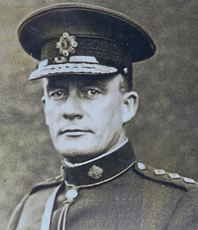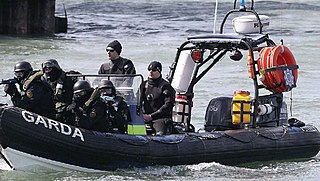Related Research Articles

The Garda Síochána is the national police and security service of the Republic of Ireland. It is more commonly referred to as the Gardaí or "the Guards". The service is headed by the Garda Commissioner, who is appointed by the Irish Government. Its headquarters are in Dublin's Phoenix Park.
Comhairle na Míre Gaile is a council established by the Government of Ireland to recognise acts of bravery which attempt to save life. It has awarded medals and certificates, and may also award financial compensation with the consent of the Minister for Justice. The National Bravery Awards are presented annually at Farmleigh by the Ceann Comhairle, the chair of the council.

Eamon "Ned" Broy was successively a member of the Dublin Metropolitan Police, the Irish Republican Army, the National Army, and the Garda Síochána of the Irish Free State. He served as Commissioner of the Gardaí from February 1933 to June 1938. He later served as president of the Olympic Council of Ireland for fifteen years.
The Special Detective Unit (SDU) is the main domestic security agency of the Garda Síochána, the national police force of Ireland, under the aegis of the Crime & Security Branch (CSB). It is the primary counter-terrorism and counter-espionage investigative unit within the state. The Special Detective Unit superseded the Special Branch, which itself replaced the older Criminal Investigation Department (CID), which was founded in 1921. They work in conjunction with the Defence Forces Directorate of Military Intelligence (J2) – Ireland's national intelligence service – on internal matters. The unit's headquarters are in Harcourt Street, Dublin City.

The Garda Water Unit is a unit of the Garda Síochána, the police service of Ireland. Formerly known as the Garda Sub-Aqua Unit, the name was changed to incorporate the services of the non-diving surfaced based marine section.

The Garda Public Order Unit – commonly known as the Garda Riot Squad – is a unit of the Garda Síochána, Ireland's police force, that deals with public disorder, including riots and protests.
The Garda Síochána Ombudsman Commission (GSOC) is an independent statutory body in Ireland charged with overseeing the Garda Síochána, the national police force. It is a three-member body established under the Garda Síochána Act 2005 to deal with complaints from members of the public about the conduct of Gardaí.

Seán Liddy was an Irish politician and founder member of the Garda Síochána. On his retirement, he also founded and became the first President of the Garda Pensioners Association (1961–1966), later to be renamed the Garda Síochána Retired Members Association (GSRMA).

Garda ar Lár was an Irish television series, the second season of which was broadcast on RTÉ One in January and February 2009. It examined incidents where members of the Garda Síochána died since the foundation of the state. Over thirty members of the force had died in this time. The series was broadcast on Mondays at 19:30.
PULSE is a computer system used by the Garda Síochána, the police force of the Republic of Ireland. The system was introduced in November 1999.

The Garda Mounted Support Unit is the horseback mounted division of the Garda Síochána.
Armed Support Units (ASU) are specialist regional firearms units of the Garda Síochána, the national police force of Ireland. Based in all four Garda regions in the country, Gardaí attached to an ASU unit carry a combination of lethal firearms and non-lethal weapons, as opposed to regular uniformed Gardaí, who are unarmed, and detective gardaí, who are armed but not assigned to ASU roles.

The Garda National Roads Policing Bureau (GNRPB) (Irish: Biúró Náisiúnta an Gharda Síochána um Póilíniú Bóithre) is the roads policing unit of the Garda Síochána. Prior to 2018, it was known as the Garda Traffic Corps (Irish: Cór Tráchta an Gharda Síochána).
William P. Quinn was born in Inniskeen, County Monaghan, Ireland. He was the son of Thomas J. Quinn, the principal of the National School. He joined the Garda Síochána in December 1922 and was the first recruit to rise through the ranks to the office of Commissioner.
The Garda National Immigration Bureau is a unit of the Garda Síochána, the police force of the Republic of Ireland. It was formed in May 2000, and is responsible for the enforcement of immigration law in Ireland.

The Jonesborough ambush took place on 20 March 1989 near the Irish border outside the village of Jonesborough, County Armagh, Northern Ireland. Two senior Royal Ulster Constabulary (RUC) officers, Chief Superintendent Harry Breen and Superintendent Bob Buchanan, were shot dead in an ambush by the Provisional IRA South Armagh Brigade. Breen and Buchanan were returning from an informal cross-border security conference in Dundalk with senior Garda officers when Buchanan's car, a red Vauxhall Cavalier, was flagged down and fired upon by six IRA gunmen, who the policemen had taken for British soldiers. Buchanan was killed outright whilst Breen, suffering gunshot wounds, was forced to lie on the ground and shot in the back of the head after he had left the car waving a white handkerchief. They were the highest-ranking RUC officers to be killed during the Troubles.
The Fennelly commission, formally the Commission of Investigation , was a commission of investigation established in April 2014 by the then government of Ireland to investigate several controversies involving the Garda Síochána. The sole member of the commission was Nial Fennelly, a retired justice of the Supreme Court. Fennelly identified three separate strands within the commission's terms of reference:
- Garda phone recordings scandal: unauthorised recordings made since the 1980s of conversations to and from some Garda stations.
- Death of Sophie Toscan du Plantier: evidence from phone recordings at Bandon Garda station of misconduct in the investigation
- Martin Callinan: circumstances of his retirement as Garda Commissioner in March 2014.

The Garryhinch ambush was a surprise attack on the Garda Síochána by the Provisional IRA on 16 October 1976. A bomb planted by the IRA in a farmhouse at Garryhinch on the County Laois-County Offaly border in the Republic of Ireland was detonated. Garda Michael Clerkin was killed in the blast, and four other Gardaí at the scene were badly wounded. The incident was one of the few occasions during The Troubles when police officers in the Republic of Ireland were deliberately targeted.
A police union is a trade union for police officers. Police unions formed later than most other occupations, reflecting both a conservative tendency and relatively superior working conditions. The first police unions formed in the United States. Shortly after World War I, the rising cost of living, wage reductions, concerns over amount of rest and growing dissatisfaction among rank and file police officers led to a number of police strikes from 1918–1923 and the formation of police unions globally.
The Garda Representative Association (GRA) is the staff association for police officers of the rank of Garda in Ireland, founded under statutory provisions. Irish law prohibits members of the Garda Siochana from joining trade unions because of a view from Government that police industrial action would pose a risk to public safety. The GRA is a 1978 reconstitution of a Representative Body for Guards (RBG) set up under 1962 regulations. Three similar organisations exist for Gardai of other ranks up to that of Chief Superintendent. As of March 2023, the association had a membership of almost 12,000. It is funded by a levy of 0.6% of the base salary of all its members.
References
- 1 2 Garda Síochána (Associations) Regulations, 1978 ( S.I. No. 135 of 1978 ). Signed on 9 May 1978. Statutory Instrument of the Government of Ireland .Retrieved from Irish Statute Book .
- ↑ Moore, Kevin (10 December 1989). "Crunch talks for garda counselling". The Sunday Independent. p. 2.
- ↑ "Association of Garda Sergeants and Inspectors (home page)" . Retrieved 24 September 2023.
- 1 2 3 Doyle, Tim (2021). Changing of the Guard. Dublin: Currach Books. ISBN 978-1-78218-929-9.
- ↑ Garda Síochána (Representative Bodies) Regulations, 1962 ( S.I. No. 62 of 1962 ). Signed on 13 April 1962. Statutory Instrument of the Government of Ireland .Retrieved from Irish Statute Book .
- ↑ "Who'll get PJ's job". The Sunday Independent . 30 September 1984. p. 28.
- ↑ MacNamee, Garreth (13 November 2021). "Garda association trustees dissatisfied over alleged 'lack of transparency' in financial issues". TheJournal.ie. Retrieved 27 September 2023.
